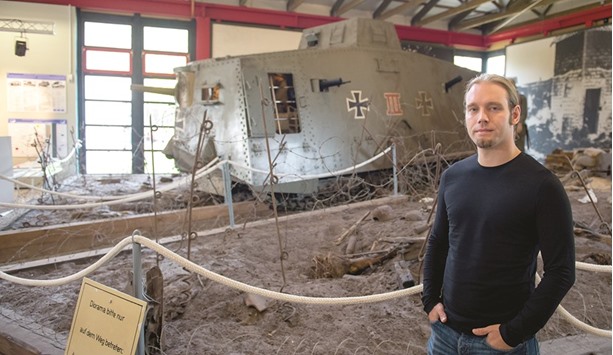The hulking grey war machine resembles a ship’s upturned hull, with one stumpy barrel protruding above the Iron Cross insignia. It’s a far cry from the Tiger and Panther tanks that ravaged WWII battlefields, but a sombre testimony to the start of a terrifying new chapter in modern warfare.
The first German tank, the A7V, was presented to the top brass for inspection in Berlin in January 1917, only a few months after the British deployed this revolutionary weapon in France in World War I.
But the decisive role the panzer, or armoured tank, would play in world history only became clear long after their debut in the bloody battles of attrition of the 1914-1918 war.
More than two decades later, Adolf Hitler’s Blitzkrieg through Europe was driven by fast tank and infantry assaults.
The A7V exhibit in the German Tank Museum, located in the city of Muenster, is a replica – the only surviving genuine example now resides in Australia.
It is hard to imagine how this seven-metre-long vehicle could house 20 men in the heat of battle. Apart from the commander, it carried 12 machine-gunners, junior officers and main gun crew.
“Conditions inside were atrocious,” says museum director Ralf Raths. “They could only move bending over, if at all, and as well as being cramped it stank and was deafeningly loud.”
There was no interior lighting, and the twin engines pushed the temperature up to an unbearable 60 degrees Celsius. The only contact with the outside world was via carrier pigeons.
The A7V was Germany’s response to the debut deployment of tanks on September 15, 1916, during the battle of the Somme. In their infancy of design, the lumbering British machines had to breach ditches and barbed wire to get at the entrenched machine-guns and artillery of the Germans.
Many of the tanks broke down, but their use still brought an extra crucial advantage in the overall outcome of the British attack, which cost around 19,000 lives on the first day in July.
“They saved blood by using tanks,” says Raths, describing the devastating effect these 30-ton leviathans had on the opposing forces.
“Many of the German soldiers in the trenches froze as the steel monsters on caterpillar tracks rolled towards them with a blaze of gunfire.”
And although they moved at the same speed as a person on foot, they seemed unstoppable: “Along the entire front German soldiers were referring to dragons and monsters.”
Despite the tactical and psychological edge tanks gave the ground forces locked in a stalemate on the Western front, generals in Germany and Austria were reticent to develop the idea, such was the lack of materials for armaments.
The available steel was desperately needed to bolster the German submarine fleet. “On land, it was deemed enough to fend off the threat of tanks with conventional weapons,” says Raths.
Unwilling to lag behind completely, the Germans still hastily developed their own tank, but its presentation in Berlin drew a lukewarm response: “The Supreme Army Command decided against large-scale tank production due to lack of resources and lack of success prospects.”
Only 20 of the vehicles were built by the end of the war, with delivery beginning in late October 1917. The first examples appeared on the front on March 21, 1918, with rather inglorious results.
The engines often overheated and the tracks came off, while the transmission constantly failed – the same problems that beset the British and French tanks.
The Allies persisted, however, and in November 1917 almost 500 British tanks broke through the German lines in the Battle of Cambrai.
“The tanks were extremely useful to the Allies, but were still no miracle weapon – they did not bring about any strategic change,” says Raths. “The Germans quickly mastered anti-tank skills and were able to capture about 100 tanks and use them themselves.”
The original pioneer of German tank design could have vanished without trace, were it not for an A7V named “Mephisto” that fell into a shell hole and was abandoned by its crew.
Australian soldiers recovered the vehicle and in 1919 it was taken to Sydney and moved to Brisbane, where today it is the last surviving example of the first German panzer. – DPA

Museum director Ralf Raths with the A7V in the background.
